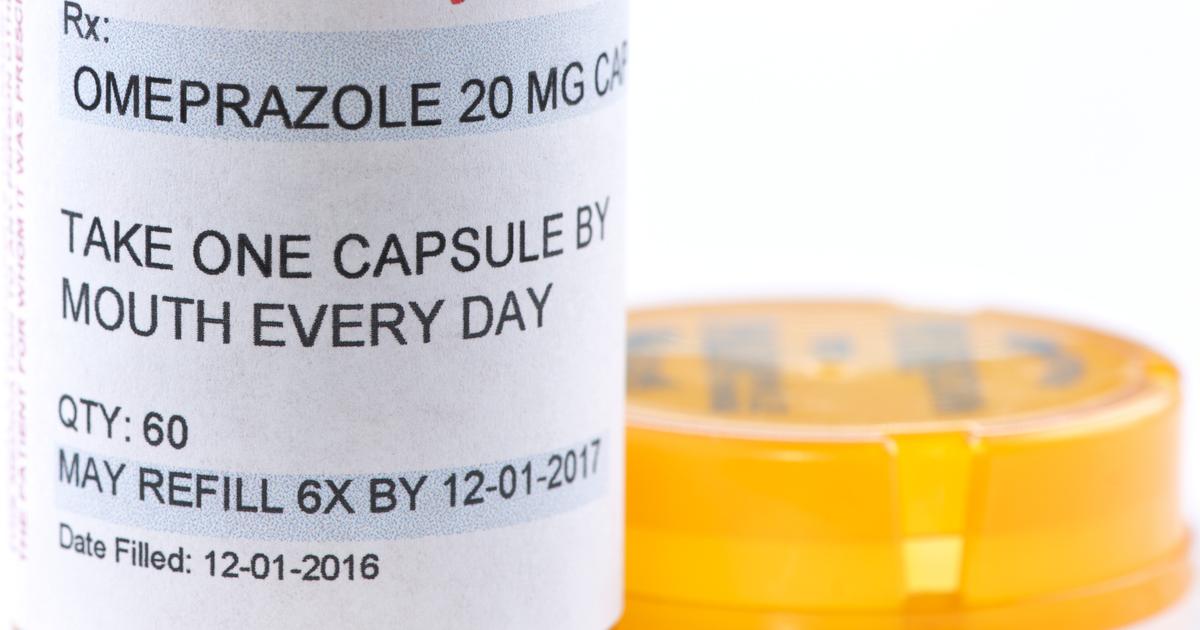What Is Omeprazole?
Omeprazole is a medication used to treat stomach and esophagus conditions. Known as a proton pump inhibitor, omeprazole is sold over-the-counter and in stronger doses with a prescription. It is available as an oral tablet and liquid suspension, and medical personnel might administer it as an injection for certain patients. The dose is determined by the severity of the patient's stomach or esophageal issues and by the patient's other medical conditions. As an oral tablet, omeprazole is available in strengths of ten, twenty, and forty milligrams. Individuals of Asian descent often need a lower dose of this medicine than other patients, particularly in cases where omeprazole is being used to treat erosive esophagitis.
The major uses, side effects, and drug interactions associated with omeprazole are discussed below.
How It Works

As a proton pump inhibitor, omeprazole works by suppressing the secretion of stomach acid. It blocks the action of the proton pump, an enzyme system located on the surface of the gastric parietal cells. Omeprazole blocks the last step in the process of stomach acid production, and it starts to work within one hour after it is taken by mouth. The full effect of the medicine is normally felt within two hours, and omeprazole can continue to inhibit stomach acid secretion for up to three days after a single dose. Once omeprazole is discontinued, the patient's stomach acid levels will return to their baseline after three to five days.
Keep reading to learn about the uses for omeprazole next.
Uses For Omeprazole

Prescription omeprazole is used to treat gastroesophageal reflux disease, gastric and duodenal ulcers, and stomach infections caused by the H. pylori bacteria. The medication can also be used to treat Zollinger-Ellison syndrome and erosive esophagitis, a condition in which there is acid-related damage to the esophagus (the tube that connects the mouth to the stomach). The over-the-counter version of omeprazole is used to treat heartburn that occurs at least two days a week in adults. It should not be taken for more than fourteen days without consulting a doctor, and it is not intended for the immediate relief of heartburn. Prescription omeprazole can be given to children who are at least twelve months old, and patients who use this form of the medicine should continue to take it even if they feel well; patients will need to talk with a doctor before stopping the prescription.
Get familiar with the potential side effects of omeprazole next.
Side Effects Of Omeprazole

Adults who use omeprazole could experience headaches, nausea, vomiting, abdominal pain, and gas. Children taking this medicine might develop a fever in addition to these side effects. Omeprazole may also cause more serious side effects for some patients. For example, blood tests could show low magnesium, especially if the patient has taken omeprazole for more than three months. Potential symptoms of reduced magnesium include seizures, fast heartbeat, spasms of the hands and feet, muscle weakness, and dizziness. Using omeprazole for more than three years might lead to a vitamin B12 deficiency too. Patients with this nutritional deficiency typically experience signs such as numbness in the hands and feet, poor muscle coordination, menstrual changes, and nervousness. This medication could also cause kidney damage, and patients with this side effect often have urinary changes and pain in the side and back.
Individuals who use omeprazole have a higher risk of wrist, hip, and spine fractures, and the medication could lead to severe diarrhea and inflammation of the stomach lining. Patients with an inflamed stomach lining usually report symptoms such as weight loss, stomach pain, and vomiting. The medication has been associated with the development of systemic lupus erythematosus, and this might trigger blood clots, weight loss, fever, fatigue, and heartburn. Some patients taking omeprazole develop cutaneous lupus erythematosus, which leads to the formation of a red, raised, and scaly rash on the body. The rash can sometimes be purple, and it may also form on the nose.
Learn about the precautions to remember in regards to taking omeprazole next.
Precautions To Remember

Before using prescription omeprazole, patients should inform their healthcare team about all medications they take, including St. John's wort, anticoagulants, and diuretics. The physician may need to adjust the patient's dose of these medicines if omeprazole is added, and they might also recommend frequent follow-up appointments for monitoring. Patients who take rilpivirine are typically advised not to use omeprazole. Since the proton pump omeprazole inhibits is stimulated by food, patients need to take this medicine on an empty stomach, and ideally with a full glass of water. It is safe for patients to continue their normal diet while taking omeprazole. If a dose is missed, the patient should take the missed dose as soon as they remember. However, if it is only a few hours before the next scheduled dose, the missed dose should be skipped. Taking two doses at once could increase the risk of side effects. Patients who use nonprescription omeprazole should let their doctor know if they have experienced heartburn for more than three months and if they have symptoms such as chest pain, shortness of breath, difficult or painful swallowing. These symptoms might be signs of a more serious medical problem that cannot be treated with nonprescription omeprazole. In addition, patients should let their doctor know if they have ever had a vitamin B12 deficiency, low magnesium levels, or liver disease.
Read about the potential medication interactions associated with omeprazole now.
Potential Medication Interactions

Omeprazole reduces the effectiveness of nelfinavir, atazanavir, and rilpivirine, and it should not be taken with any of these medicines. Omeprazole also reduces the effectiveness of clopidogrel, and this could lead to blood clots, so patients who take clopidogrel should not take omeprazole. Individuals who take high doses of voriconazole might need a lower dose of omeprazole to avoid side effects, and omeprazole significantly increases the amounts of warfarin, digoxin, saquinavir, and tacrolimus in the body. Patients may have their doses of these medicines lowered while they are taking omeprazole. Antibiotics such as ampicillin may not be as readily absorbed by the body while patients are taking omeprazole, and omeprazole also interferes with the body's ability to absorb iron-containing products. Patients using erlotinib as part of their cancer treatment should speak to their healthcare team; omeprazole can interfere with the effectiveness of this treatment.
Learn about the commonly prescribed alternatives to omeprazole next.
Commonly Prescribed Alternatives

Patients who cannot use omeprazole may be prescribed esomeprazole, pantoprazole, ranitidine, or famotidine. Other commonly prescribed alternatives include simethicone, calcium carbonate, and magnesium hydroxide. Some of these alternatives are available over-the-counter, and stronger doses of the same medicines may be prescribed by a physician. Some doctors may suggest lansoprazole as an alternative medication for omeprazole as well. Patients should tell their doctor about all over-the-counter medicines and prescriptions they take, and the physician also needs to know about all vitamins, minerals, and supplements the patient uses. When discussing the need for alternative medications, the patient should mention any known allergies to medicines and any side effects experienced while taking omeprazole.
Learn about how dosages of omeprazole work next.
Dosage Factors

Proper dosages of omeprazole vary depending on the patient's age, overall health, and the condition for which omeprazole is being used. Adults with duodenal ulcers will normally be prescribed twenty milligrams each day for four weeks, and the adult dosage for treatment of a Helicobacter pylori infection is forty milligrams per day for fourteen days. Patients who use omeprazole for the treatment of this infection will usually take the omeprazole together with clarithromycin. Adults who have erosive esophagitis generally take twenty milligrams of omeprazole each day for four to eight weeks. Pediatric patients with this condition are dosed based on weight. Patients between one and sixteen years old who weigh between ten to 19.9 kilograms should take ten milligrams of omeprazole each day for four to eight weeks. Pediatric patients who weigh at least twenty kilograms can take the standard adult dosage of twenty milligrams per day. Individuals who have liver issues are advised to take only ten milligrams per day as a maintenance dose for healing from erosive esophagitis, and patients with kidney conditions can take the standard adult dose.
Learn about who shouldn't take omeprazole next.
Who Shouldn't Take It

Patients who are allergic to esomeprazole, lansoprazole, pantoprazole, or rabeprazole should not use omeprazole. The medication may not be safe for use by patients with liver disease, osteoporosis, or osteopenia. Individuals who use HIV medications containing rilpivirine should not take omeprazole, and the medicine should be used with caution in patients who have a history of difficulty swallowing. Patients should ask their healthcare provider or pharmacist before purchasing over-the-counter omeprazole if they have stomach pain, nausea, vomiting, frequent chest pain, wheezing, or unexplained weight loss. Individuals who know they have low magnesium should also ask a physician before taking this medication, and medical advice should be obtained before using omeprazole if heartburn has continued for more than three months. Omeprazole should not be given to children unless a doctor has been consulted. Additionally, patients who have noticed unexplained weight loss or blood in their stools should check with a clinician before taking this medication.
Get some tips for taking omeprazole next.
Tips For Taking It

Omeprazole typically needs to be taken at least one hour before eating, and patients should check the leaflet that comes with their medication for advice on medication timing. When using the oral suspension (liquid) version of this medicine, the patient should shake the bottle before dispensing the dose. The provided dosing syringe should be used to measure the appropriate dose; a kitchen spoon is not accurate. Patients who use the capsule form of omeprazole must swallow the whole capsule. Those who cannot do so may open the capsule and place the contents in a spoonful of applesauce. The applesauce must then be consumed immediately. Omeprazole comes in a powdered form, and this needs to be dissolved in a tiny amount of water. Patients should drink the water immediately, and individuals who use a nasogastric tube can take it with a catheter-tipped syringe. When over-the-counter omeprazole is used, this must be taken for no more than fourteen days. Patients can expect their symptoms to improve within one to four days. After using over-the-counter omeprazole for fourteen days, the patient needs to wait at least four months before starting a new fourteen-day course of over-the-counter omeprazole. Omeprazole could affect certain laboratory tests, and patients should let all of their healthcare providers know they are taking this medicine. Omeprazole should be stored at room temperature, and it needs to be kept away from heat and moisture.
Uncover the symptoms of omeprazole overload next.
Symptoms Of Omeprazole Overload

Patients who take too much omeprazole could develop symptoms of omeprazole overload. For example, the patient may feel nauseous, and vomiting could occur. Vision could become blurry, and the patient might begin to sweat profusely. They could feel very drowsy and confused, and a rapid heartbeat may be present as well. The symptoms of omeprazole overload will depend on how much of the medication the patient has taken and on whether it was consumed with alcohol or with any other medicines. Patients who exhibit these symptoms should be taken to an emergency room for evaluation. Doctors at the emergency room will need to know how much omeprazole the patient took, when the overdose occurred, and whether alcohol, recreational drugs, or medicines were taken along with the omeprazole. The patient will be placed on a cardiac monitor, and their vital signs will be checked regularly. Treatment generally involves treating the symptoms that occur as a result of the overload. Patients will be given supportive care that could include breathing assistance, anti-nausea medicines, and fluids.